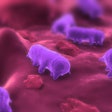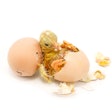A system developed to disinfect fruits and vegetables can significantly reduce Salmonella prevalence on the surface of hatching and table eggs, as well as egg crates.
The technology was born out of a need in the produce industry to sanitize fruits and vegetables after a Listeria outbreak in 2015, explained Paul Moyer, co-owner of disinfection company Clean Works.
“We have a technology that works well in the healthcare field and the produce world, but we're realizing it could potentially make a big impact in food safety and the poultry industry,” said Moyer.
About the technology
The technology uses a combination of hydrogen peroxide, ozone and ultraviolet (UV-C) light to generate powerful hydroxyl-radicals that inactivate microbes and pathogens. The system does not use water, as it can be a vector for pathogens, and takes less than 30 seconds for a crate of eggs to pass through.
“The combination of the three components causes the generation of hydroxyl-radicals, which is what kills the bacteria,” said Keith Warriner, University of Guelph Food Science Professor.
In a verification study conducted in conjunction with the University of Guelph, shell eggs were inoculated with Salmonella and Campylobacter. After the eggs were disinfected using the hydroxyl-radical system, the number of bacteria was reduced and no quality attributes were affected. In a similar study, egg crates that were disinfected showed a seven-log reduction of Salmonella.
In commercial validation studies that examined up to 7,000 hatching eggs disinfected by the ozone technology, no negative effects on the hatch rate were observed, a seven-day mortality rate of 0.3% was documented and the chicks appeared to be healthier compared to the control group, explained Denise VanderVeen, Clean Works Director of Business Development.
After discovering the disinfectant system’s preliminary effects on mortality rates and chick health, Warriner said the company’s future research efforts will focus on those variables.
“Europe is ahead of the U.S. by approximately 10-15 years. European countries are starting to ban the use of formaldehyde in hatcheries. Looking at different sanitation techniques we can use is important,” added Dr. Mike Wineland, consultant with Hatchery Consult.
















